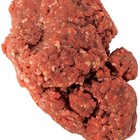KateSmirnova/iStock/GettyImages
Innovative gourmands have found lots of clever ways to dehydrate food: posh dehydrators, oven warming drawers and carefully arranged electric space heaters. Most of these, however, require power and patience in equal measure. If you're looking for a more rustic method, take a page from pioneer history and dehydrate your food mostly gadget-free.
"Without Heat" Is a Misnomer
While you can certainly dehydrate food without plugging in to power or turning on the gas, some form of gentle heat is a necessary element in the process. After all, the basic principle of dehydration involves heat: essentially, it's the movement of warm air around the subject of the drying, whereby the warm air rises and brings moisture with it.
Gentle Treatment
The gentle heat required for dehydration -- around 100 degrees Fahrenheit, according to the University of Illinois at Urbana-Champaign College of Agriculture -- varies according to the thickness and native moisture content of the food. For example, drying paper-thin strips of meat into jerky will require less warmth and less time than drying big grapes into raisins. The idea is to find a level of heat that dries the food without cooking it; when the outside of the food dries too quickly, the dry "shell" traps moisture inside the food.
Air Flow
The drying food must have steady, gentle air flow around it in order to move the moisture away. Sometimes, this requires a fan set to low; however, strong airflow is likely to either blow the food away or blow dust onto the food, so don't overdo it.
Solar Drying
Solar drying is the simplest non-gadget-requisite method of dehydration. Best suited for arid climates, solar drying involves slicing the food into the thinnest possible pieces, arranging them in a single layer on screens or thinly stretched cloth, then placing the screens in full sun. The food must be covered at night to protect it from gathering dew and watched during the day to scare off snacking wildlife.
Indoor Drying
To dry food in a warm indoor environment, you can use the same methods as Native Americans and medieval housewives did. Herbs, leafy greens and flowers can be bunched, covered lightly with cheesecloth or mesh, and hung from the ceiling. Alternatively, stretch bedsheets tightly between mooring points to dry greens and paper-thin slices of fruit and vegetables. Another method is to "sew" slices on a long thread, making sure to leave space between each piece for the air to move through.
Meat and Fish Safety
Unless you're in Arizona and it's the middle of July, you will need something hotter than a room-temperature environment to safely dry meats and fish: otherwise, insects will lay eggs in the food. If you're unwilling or unable to dehydrate using power, dry these foods close to fire and pre-salt the pieces. When the meat or fish becomes brittle, it's ready to store.
Related Articles

How to Dry Radishes

How to Reheat Chinese Takeaway

How to Store Cashmere From Moths

How to Store Dehydrated Foods

Dehydrated Fruits & Vegetables ...

Fruits & Vegetables: Carbon Dioxide ...

How to Dry Cheese

How to Do a Blow-Dry Wrap

How to Dry Corn for Popcorn

Care Instructions for Voile Fabric

How to Stretch Wool After Shrinking It

How to Assemble a Food Mill

How to Cook With a Gas Fireplace

How to Dehydrate Ground Beef

Parts of a Hair Dryer

How to Dry Pineapple in a Dehydrator

How to Dry Pumpkins

How to Dry Sliced Oranges in the Oven

What Are Some Absorbent Fabrics for ...

How to Dry Fresh Parsley
References
- University of Illinois at Urbana-Champaign College of Agriculture: Drying Food
- The Complete Guide to Drying Foods at Home; Terri Paajanen
Writer Bio
Annette O'Neil is an air sports athlete, digital nomad, full-time traveler and yogini. A writer for more than a decade, O'Neil has written copy, content and editorial articles for hundreds of clients and publications, including Blue Skies Magazine and Whole Life Times.